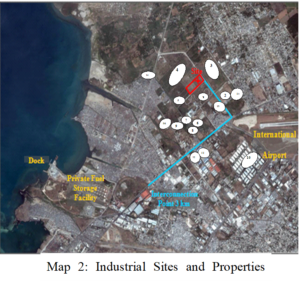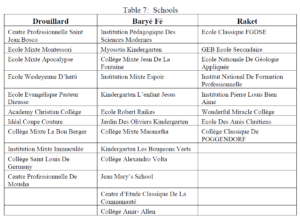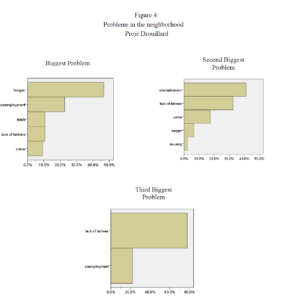This post mostly comprises a study I did in 2008 of three Site Soley communities. I want to make it clear that I am by no means trying to portray myself as an expert on Site Soley. I have only visited the place half a dozen times, and done two small surveys in the neighborhood. The one described in this post was conducted in early 2008. The other was a study I did in 2013 for an NGO that was trying to help Osklen Fashion house of Brazil pretend like they were putting people in the Site to work (they employed thirteen people for some 2 weeks). But there is a scarcity of data online about the community, so I’m sharing this short summary of data I cobbled together for the 2008 report as well as the results from the study.
History Brief: Site Soley (Cite Soleil)
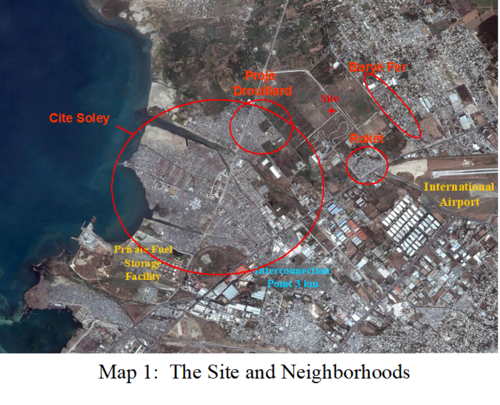
Overview of a 2008 Social Survey
In 2008 we conducted a socio-economic survey of the three Site Soley communities closest to the site of E-Power thermoelectric plant, not yet built at the time (see Map at beginning of this post). The number of household heads interviewed in each area was chosen based on the size and significance of the neighborhood. The three neighborhoods were: Projé Drouillard, Raket, and Baryè Fè. All are located within the political administrative district (Commune) of Cité Soley. The number of household heads interviewed in each community was decided based on the size and proximity to the plant. Baryè Fè was the closest and hence included the most interviews (112). Drouillard was the largest community but at a greater distance, hence a smaller number of household heads were chosen (75). Raket was the smallest and most distant community and hence the fewest people were chosen to be interviewed (40). Selection of specific houses was systematic and random.
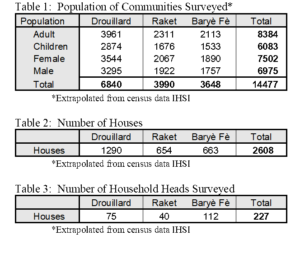
A team of six researchers, four interviewers and two supervisors, spent two days interviewing household heads or, in cases where the household head was not present, the oldest adult present at that time. Houses were chosen by a system of random cluster sampling. In the 18% of cases where no adult was home, interviewers went to the next chosen house.
Interviewers informed the subjects that a thermoelectric plant would be installed nearby; that one consequence would be noise; and they discussed other possible consequences and objections. No residents posed any objections. Less than five percent refused to give their names. Most signed the survey questionnaires, requested as evidence of the interviews and information provided.
The lack of objections is likely a reflection of the deepening economic crisis that afflicts the area. In the past 25 years political turmoil has led to the closing of the local sugar production plantation and factory as well as duty free zones. An estimated 100,000 people lost their jobs.
History of Site Soley
In colonial times (pre-1804) the area that surrounds the thermoelectric plant site was part of the Pierre Morel sugar plantation. With the early 20th century expansion of US sugar companies into the Caribbean, the plantation became part of the US owned Haitian-American Sugar Company (HASCO; founded in 1912).[i] Baryè Fè began as a plantation housing site. Drouillard and Raket began later, during the 1960s and 1970s, as part of a government displacement of squatter settlements that surrounded the city’s wharf. The communities also emerged in the wake of what is known as the American Plan, the USAID promotion of the offshore assembly sector in Haiti. Heavy investments in factories and infrastructure were made with the goal of stimulating industrial development; concomitant to these investments the government allowed—if not actively encouraged—settlement in the area, the goal being to provide a readily accessible pool of labor. Although never completely abandoned, the plans were derailed by political instability. Many of the factories and businesses in the area were destroyed by mobs. Those that were not destroyed—primarily factories oriented toward production for the domestic market–reportedly paid political/gang leaders for ‘protection’ (see Photo Map 2).
Current Conditions
The Cité is the most densely populated, impoverished, and violent barrio in Haiti. It is broken into 17 neighborhoods with smaller sections inside. Located between the Baie de Port-au-Prince, the port, and Rout Nationale 1, the Cité covers 205 hectares (2.5 square kilometers). A 2003 survey put the population at 350,000, translating to 140,000 people per square kilometer, among the most densely populated urban areas in the world. The average per capita income is less than US$1 per day.
The Cité is between two ravines that drain much of upper Port-au-Prince, bringing additional garbage and human waste with every downpour. There is a lack of effective garbage removal, waste disposal, and other sanitary services. Typhoid, malaria, dysentery, hepatitis, and HIV are the principal diseases affecting the people there. The infant mortality rate is unknown but believed to be over 100 per 1,000 births. According to Arbaud survey, there is only one hospital, Sainte-Catherine Labourée, (with 110 beds), one public preschool, one public primary school, and two public high schools. The local cemetery is full. A summary of statistics from the recent INURED survey (2008) is provided below. (Note that the percentage of the population that is female is 15% higher in Cité Soley than in calculations of the neighborhoods surveyed in our study. These later figures were extrapolated from the most recent Haitian census. Based on other demographic studies in Port-au-Prince, where the ratio of women to men is consistently high, the error is likely in the census-based calculations.)
Statistical Profile of Citè Soley (source INURED 2008)
- 2.5 square kilometers
- 350,000 people
- 67% female
- 50% own their own residence, the remainder rent homes
- 80% live on less than one dollar per day
- 35.5% are protestant; 50% Catholic
- 5.2 people per household
- 3.2 children per household
- 11% have potable water in their homes
- 59% have no latrine
- 37% have a radio and the same percentage have televisions
- 6% have a refrigerator
- 63% of people interviewed have a cell phone
- 25% have at least one family member abroad
- 33% identify themselves as tailors,
- 21% work with cement in house construction
- 13% cook food for resale
- The average years of formal schooling is six
While perhaps better off in terms of crime and sanitary conditions, the above findings can be generalized to Raket and Baryè Fè. As will be seen in sections below, Baryè Fè is cosmetically better off and of a higher socio-economic standing, but there is little difference in terms of household composition, education, and perception of living conditions and neighborhood problems.
Projé Drouillard, Raket, and Baryè Fè
Overview
Of the three communities, Baryè Fè is inhabited by people of higher socio-economically status. The houses are larger, there is more space between them, roads and pathways are wider. When interviewed, residents were quick to disassociate themselves from the nearby Citè Soley (also spelled Cité Soleil; of which Drouillard is a part; and which is the most notorious and feared barrio in Haiti). There is agricultural land nearby and the people, while poor, are significantly better off than the in Citè Soley.
Raket is distinct from both areas in that it is a walled and isolated barrio. It is smaller than Baryè Fè or Drouillard, it is not connected to extensive squatter settlements as these other areas (see Map 1 above), but the houses are more similar in size to those of Drouillard—meaning small. It resembles an outpost of the Cité Soley in terms of crime and security.
Drouillard is located at the edge of Citè Soley (referred to from hereon as ‘the Cité’) and it is a special case. It will be the most important social factor bearing on the future of the thermoelectric plant and it is considered the most important factor in the political stability of the entire country. Violent opposition in the Cité is seen by the authorities as the greatest impediment to political stability. For these reasons we have given special attention to the area in the sections below and in the section on security.
Housing
In Baryè Fè and Projé Drouillard the average and median household size is close to 5.2, the national average and trend found consistently throughout Haitian communities (two adults and three to four children). Raket, with a mean of 6.1 people per household and a median of 6.0 people per household is an exception. A possible reason for this is the work in factories: The proximity of Raket to the factories provides an incentive to greater number of household members. Note in this respect that Raket is a walled community, situated in the midst of corporate owned property and there is no room to add more households.
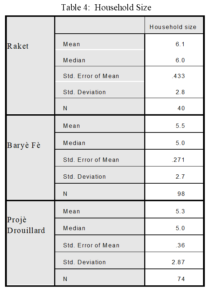
Household Composition
Also as true in much of Haiti, there is a high number of consensual unions in comparison to developed countries. However, the rate of marriage can be construed as high in comparison to Haitian tradition of non-legal union. The increasing marriage rates are a consequence of the widespread conversion from Catholicism to Protestantism that has occurred in the past forty years.
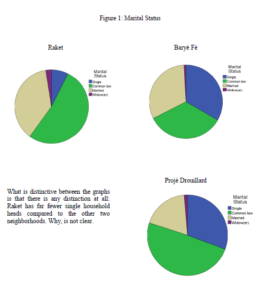
Migration
All three neighborhoods have rapidly expanded over the past 30 years, a fact evident in the relatively recent arrival of most household heads. The median time since arrival in Baryè Fè is 10 years, a full five to seven years less than the other areas. However, while Baryè Fè has experienced greater recent immigration, Raket appears to the be youngest of the communities: With average age of household head in all three barrios ranging from 36 to 38 years of age, it can be inferred from the standard deviations in Table 5 that almost no households heads were born in Raket; few in Projé Drouillard and, reflecting the long history of Baryè Fè, at least some household heads were born there (In a “normally” distributed population, about 68% of the scores fall within one standard deviation of the mean and about 95% of the scores fall within two standard deviations of the mean).
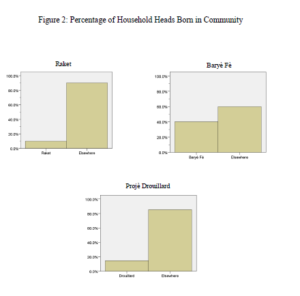
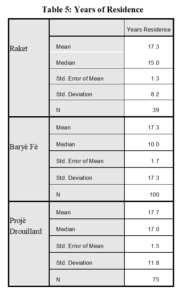
Economy and Employment
In Haiti 76% of the population live on less than US$2 per day, while 55% live on less than one US dollar per day. Most of the residents in neighborhoods near the plant—poor neighborhoods even by Haitian standards–fall in the lowest income categories. The factories near the site, for example, pay and average of US$1.33 per 10 hour work day.
“Marketing”—meaning itinerate buying and selling in Haiti’s many open air markets—is an almost entirely female dominated activity and its importance as a means of household income was clear in every neighborhood. [ii]
Also notable is that employment as motorcycle “taxis” is prominent in Raket and Baryè Fè but not in Drouillard. Many people of Raket are employed by the factories in the area while very few of those in Baryè Fè and Drouillard hold factory jobs.
It is not clear what is meant by “unemployed” as every household must have some source of income. Perhaps the answer can be found in remittances from migrants. In follow-up questions remittances were mentioned in many cases and the INURED (2008) study in the area suggests that at least 25% of homes receive some help from overseas.
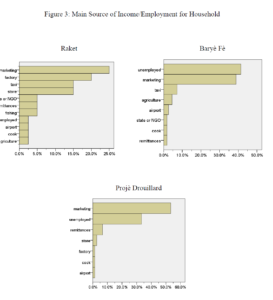
The average educational level attained per adult household head was 6.4 years in the case of Raket and Baryè Fè and 6.3 years in the case of Projé Drouillard (see Table ## ). These figures are close to average 6 yuears of education found for Cité Soley residents during the INURED (2008) survey. Most schools in the area are under-staffed, under-equipped, and of poor quality. A list of schools in each area is provided in Table.
Problems Afflicting the Area
In all three areas residents were asked the first, second, and third biggest problems in the neighborhood. The responses were consistently hunger, lack of latrines, unemployment, trash, and crime.
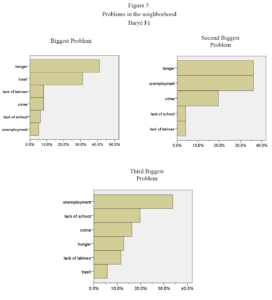
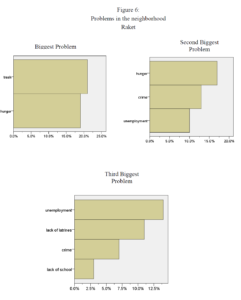
Natural and Man Made Disasters
All the regions suffer from occasional flooding. In Raket the canal that drains from La Perle SA (a bleach plant) runs through the neighborhood. It is too narrow and with the excess garbage thrown into the canal it frequently backs up.
The Varreux plant of Electricite d’Haiti (EDH) 800 meters from the Cité. During the 1990s diesel fuel leaking from the plant drained through the Cité via a canal. Between November 27th and the 29th 1996, the canal caught fire. The two blazes destroyed close to 200 shacks in the district known as “Soleil 9”.
Sanitary Services and Conditions
During the past decade violence has disrupted the few services that exist(ed). During 2005 the International Committee of the Red Cross (ICRC) cleaned some canals, assisted in refuse collection in the Cité, restored 50 public water points, and put two bore wells back into action. In that year residents had access to clean water for 250 days, called a “marked improvement” over the previous year.
Health Care
Health Care facilities in the neighborhoods are basic and provided through the local clinics listed below. Many if not most residents still rely heavily on traditional curers, including masseuses, midwives, leaf doctors, and shaman.
Beginning in June 2004, the ICRC began to train and support Haitian National Red Cross Society first-aiders in Cité-Soleil. Their job was to evacuate victims of violent clashes and take them to the nearest medical facility, Sainte-Catherine Labourée (with 110 beds) located in Cité Soley. Médecins sans Frontières runs the pediatric, medicine and maternity ward with a per month average of 450 patients hospitalized, 1,500 consultations and 200 deliveries.
Fire Stations and Other Public Services
In case of fire citizens of the area must rely on the Champs Del Mar fire station, the only one in lower Port-au-Prince, located more than ## kilometers away. During an inspection of the station we found that six fire trucks were out of service; only three fire trucks and two water trucks functioned. The director responsible for the fire station would provide no further information.
Industries in the area have their own security and emergency services. The industrial park has police, customs, and other emergency services contained within its fences.
Security
Security is the most important impediment to normal daily routines. Droiullard is in Citè Soley and has suffered some of the worst violence that has afflicted the Cité in the past five years; Baryè Fè is considerably more peaceful than nearby Cité Soley; Raket is very much like a small outpost of the Cité both in terms of houses being small and close together and in terms of insecurity and high crime. On the 27th of February 2005 in the wake of political violence, many residents of Raket were forced to leave until after the 2006 elections. Once again, the most significant factor in the area is the Cité and a description of chronology of violence there illustrates the insecurity that plagues the area.
Politicized by activities of former Priest turned President Jean Bertrand Arisitide, the neighborhoods of the Cité have been the special concern of all recent governments. Upon the first ousting of Aristide (1991), the military junta reportedly killed three-thousand people in the Cité. Politically active individuals were the subsequent target of intimidation through rapes, beatings, arrests, and assassinations.
In 1996, after the return of Aristide and disbanding of the military junta, Aristide supporters formed neighborhood vigilance brigades and took possession of arms caches from former para-military anti-Aristide supporters. Some of the arms were turned over to the police but many were kept by Aristide supporters.
The organization Jeunes Bas Soleil 9 (OJBS9), one of the most active popular organizations in the Cité, subsequently turned into an armed para-military organization.
When Aristide was ousted for a second time in 2004 it is widely believed that he gave more arms to the informal para-politico-military organizations in the Cité. Between 2004 and 2007 the area was considered violent, gang run, and the headquarters from which many kidnappings were carried out elsewhere in Port-au-Prince.
In 2007 the United Nations security forces, (MINUSTAH) together with the Haitian National Police led a military campaign against the “gangs.” The area has since become significantly calmer.
Chronology of MINUSTAH Security Activities in Cité Soley
The UN mission’s military component (MINUSTAH)[iii] began in June 2004 under a United Nations mandate. It is led by the Brazilian and Chilean armies. The current mission is authorized until October, 2008.
As of May, 2008, the force was composed of a total of 9,055 uniformed personnel which included 7,174 troops and 1,881 police, supported by an international civilian personnel, a local civilian staff and United Nations Volunteers. Its July 2007 – June 2008 budget was $535.37 million (more than half the $1.045 billion Haitian National budget for the same year). The major recent focus of their efforts has been Cité Soley. A summary of security related events is provided below:
- According to the commander of MINUSTAH, Between 2004 and 2007 as many as 600 shots could be heard every day in Cité Soleil
- In 2005, 692 wounded people were evacuated from the Cité.
- On July 6, 2005 MINUSTAH armored vehicles supported by helicopters made an incursion into the Cité; as many as 80 people were reported killed.
- Friday, December 22nd, starting at approximately 3 a.m. another MINUSTAH incursion targeted the Bois Neuf and Drouillard neighborhoods. One observer put the number of dead at five.
- In January 2006, two Jordanian peacekeepers were killed in Cité Soleil
- In October 2006 the Haitian National Police and UN troops entered the Cité and remained for one hour after which they began to increase patrols and maintain a greater presence
- In late January 2007 four people were killed and another six injured in a UN operation exchange of fire with “criminals” in Cité Soleil
Since then more incursions and police presence in the Cité has led to a greater security. The INURED (2008) study reported that 60% of residents see police in the streets of their neighborhood daily and 90% feel safer when they see police.
MINUSTAH maintains an armed checkpoint at the entrance to the Cité and one in Raket, near the Acierie d’Haiti.
Urban Planning
A 2003 United Nations survey found that there are 170 projects either planned or underway in the areas and while the region is currently the target of the USAID funded Haitian Stabilization Initiative (HSI), part of which is the Programme de Réhabilitation Urbaine dans Cité Soleil, including in the program are a US$100 million dollar urban planning project (extending Rout 9, Avenue Soleil to Route Saline). Nevertheless, life continues to be extremely difficult for the people living in the Cite.
International Organizations and ONGs
Most Important Organizations Working in the Area
- RCV : Réduction de la Violence Communautaire, MINUSTAH
- CNDDR : Commission nationale de désarmement et de réinsertion
- OIM : Organisation Internationale pour les Migrations
- Konbit pou Lape (MINUSTAH)
- Médecin sans frontière
- Médecin du monde
- USAID
- La Croix Rouge Haïtienne
- International Committee of the Red Cross (ICRC)
- PAM (Programme Alimentaire Mondial)
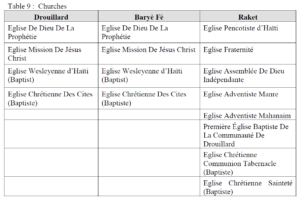
Social Leaders
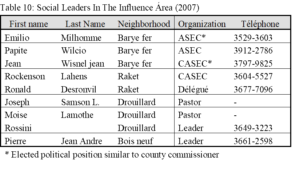
WORKS CITED
DAA (Daniel Arbour and Associates)
2007 Préparation D’un Programme De Réhabilitation Urbaine Dans Cité Soleil Dossier Février 2007 Report For, Programme De Remise En État De L’infrastructure. Économique De Base (Preieb) Ministère Des Travaux Publics, Transports Et Communications (Mtptc) Ministère De L’économie Et Des Finances– République D’haïti Prêt Bid 1493/Sf-Ha Dans Cité Soleil
David Becker USAID
Donald Gregory William, Commissaire de Police, Port-au-Prince
INURED (Interuniversity Institute for Research and Development)
2008 Cité Soleil Project. Report funded by USAID.
MINSUSTAH
http://www.forces.gc.ca/site/Community/MapleLeaf/article_e.asp?id=3776
http://www.un.org/depts/dpko/missions/minustah/facts.html
Ronald Semelfort, Directeur Centre National de Meterologie
Sinan Al-Najjar- Program Manager, Haitian Stabilization Initiative (HSI)
CHF International, Haiti (509) 3701 6309
This Week in Haiti. 1996 Cité Soleil: Government throws oil on fires of frustration Haiti Progres, This Week in Haiti, Vol.14 no.37, 4–10 December 1996 http://www.hartford-hwp.com/archives/43a/333.html
Waldo Colas , Geographer, Centre National de Meterologie
NOTES
[i] HASCO was founded on August 5th 1912 in Wilmington, Delaware, by Charles Steinheim, John A. Christie, and Franck Corpay. It became one of the nations major industries and sources of employment. Threatened by political turmoil in Haiti in the years leading up to 1915, the security of the company was used as part of the justification for the 1915-1934 US military occupation of Haiti.
[ii] In rural areas retail vending in open, rotating markets is almost completely dominated by women. The only exceptions are traveling pharmaceutical salesmen and the occasional vendor of pesticides. In urban areas men are more involved in itinerant retail marketing, selling shoes, videos, phone cards a water. The rise of male involvement in this type of marketing is recent and appears to be a reflection of the changing Haitian economy and influence from the Dominican Republic where men dominate itinerate trade.
[iii] Mission des Nations Unies Pour la Stabilisation




